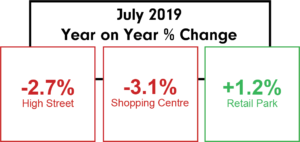 New figures have revealed that retail footfall was down 1.9% last month, which represents the worst July decline since 2012.
New figures have revealed that retail footfall was down 1.9% last month, which represents the worst July decline since 2012.
According to data from the British Retail Consortium (BRC) and Springboard covering the four weeks from June 30 to July 27 July, high street footfall dropped by 2.7%, following an increase of 0.3% in July last year. The three-month average decline is 4.0%.
Retail park footfall increased by 1.2%, following July 2018 when footfall decreased by 0.5%. The three-month average growth is 0.2%.
Shopping centre footfall declined by 3.1%, following July 2018’s decline of 3.4%. The three-month average decline was 3.0%.
Meanwhile, the national town centre vacancy rate was 10.3% in July, a slight increase on the previous quarter’s rate of 10.2% and the highest since January 2015.
Springboard marketing and insights director Diane Wehrle said: “July was a much more challenging month for high streets and shopping centres than for out-of-town destinations. Some of the -2.7% drop in high street footfall was a consequence of a strong comparable of +0.3% last year, when we had a continuous period of hot sunny weather.
“But for shopping centres – with the -3.1% drop being as almost as severe as the -3.4% drop in footfall last year – the weather clearly has less impact on footfall than the challenges created by the ongoing structural change in retailing. Indeed, the ongoing challenges faced by bricks-and-mortar destinations is reflected in the rising vacancy rate, which has increased in every quarter since January 2018 and now sits at 10.3%.
“Consumer demand is ever more polarised between convenience and experience, and the stronger performance of out-of-town destinations where footfall rose by +1.2% in July reflects the fact that retail parks are successfully bridging the convenience-experience gap. They not only offer consumers accessible shopping environments with free parking and easy ‘click and collect’ opportunities for online purchases, but many also combine this with an enhanced experience that includes coffee shops and casual dining restaurants, and some also have leisure facilities.
“The attraction of retail parks was demonstrated clearly in the last week of the month when temperatures reached record levels. With temperatures peaking at nearly 40 degrees on the Wednesday and Thursday of that week, footfall in high streets and shopping centres declined by an average of -7% on those two days, but only by -0.5% in retail parks. Indeed, the positive footfall result for out-of-town destinations in July, particularly the fact that footfall rose by +2.1% during day time trading hours, demonstrates that if the offer is right, consumers will spend.”
BRC chief executive Helen Dickinson OBE added: “Retailers faced a challenging environment in July, with declines in footfall on high streets and shopping centres. Sluggish sales growth and declining footfall also contributed to the rise in town centre vacancies, which rose to their highest level since January 2015. High streets and town centres play an important part in our local communities, and we should be concerned by the rise in empty store fronts.
“If the government wishes to avoid seeing more empty shops in our town centres then they must act to relieve some of the pressure bearing down on the high street. Currently, retail accounts for 5% of the economy, yet pays 10% of all business costs and 25% of all business taxes. The rising vacancy figures show this is simply not sustainable. We need an immediate freeze in rates, as well as fixing the Transitional Relief, which leads to corner shops in Redcar subsidising banks in central London.”
 Housewares Business-to-business magazine for housewares retailers and their suppliers
Housewares Business-to-business magazine for housewares retailers and their suppliers



